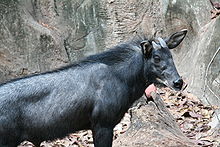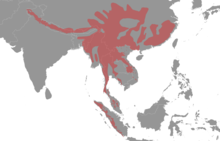The mainland serow (Capricornis sumatraensis) is a species of serow native to the Himalayas, Southeast Asia and China.[3][1]
| Mainland serow | |
|---|---|
 | |
| Scientific classification | |
| Domain: | Eukaryota |
| Kingdom: | Animalia |
| Phylum: | Chordata |
| Class: | Mammalia |
| Order: | Artiodactyla |
| Family: | Bovidae |
| Subfamily: | Caprinae |
| Genus: | Capricornis |
| Species: | C. sumatraensis[1] |
| Binomial name | |
| Capricornis sumatraensis[1] (Bechstein, 1799) | |
 | |
| Synonyms | |
| |
Taxonomy
In 1831, Brian Houghton Hodgson first described a goat-like animal with short annulated horns occurring in montane regions between the Sutlej and Teesta Rivers under the name "Bubaline Antelope".[5] As "Bubaline" was preoccupied, he gave it the scientific name Antelope thar a few months later.[6]When William Ogilby described the genus Capricornis in 1838, he determined the Himalayan serow as type species of this genus.[7]
Teeth from C. sumatraensis were found in a dig from Khok Sung, estimated to originate from the Middle Pleistocene.[8]
Characteristics
The mainland serow possesses guard hairs on its coat that are bristly or coarse and cover the layer of fur closest to its skin to varying degrees. The animal has a mane that runs from the horns to the middle of the dorsal aspect of the animal between the scapulae covering the skin. The horns are only characteristic of the males and are light-colored, approximately six inches in length, and curve slightly towards the animal's back. The mainland serow, both male and female, is around three feet high at the shoulder, and typically weighs around 200 lb (91 kg).[9][10]
Distribution and habitat
The Himalayan serow inhabits hilly forests above an elevation of 300 m (980 ft), but descends to 100 m (330 ft) in winter.[11] It prefers elevations of 2,500–3,500 m (8,200–11,500 ft) in the Himalayas.[12]
The mainland serow is found in central and southern China, Vietnam, Cambodia, Laos, Myanmar, Thailand, and in the Indonesian island of Sumatra. Its distribution follows forested mountain ranges.[13][14]
The mainland serow inhabits steep, rugged hills up to an elevation of 4,500 m (14,800 ft). It prefers rocky terrain but is also found in forests and flat areas. It is able to swim to small offshore islands. This species has a moderate level of tolerance to human disturbance, and could persist well in habitat fragments and secondary forests, though avoiding farmlands.
Behaviour and ecology
The mainland serow is territorial and lives alone or in small groups.[15]Females give birth to a single young after a gestation period of about eight months.[16]
Conservation
The mainland serow is protected under CITES Appendix I.[3]
References
External links

